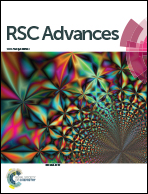Nanocellulose supported hierarchical structured polyaniline/nanocarbon nanocomposite electrode via layer-by-layer assembly for green flexible supercapacitors†
Abstract
The development of a hierarchical structured multicomponent nanocomposite electrode is a promising strategy for utilizing the high efficiency of an electroactive material and improving the electrochemical performance. We propose cellulose nanofibril (CNF) aerogels with a nanoscale fiber-entangled network as the skeleton (via layer-by-layer (LbL) assembly) of electroactive materials polyaniline (PANi), carboxylic multiwalled carbon nanotubes (CMWCNTs), and graphene oxide (GO) to obtain structurally ordered polymer–inorganic hybrid nanocomposite electrodes for high-capacity flexible supercapacitors. The uniformly distributed multilayer nanoarchitecture, interconnected network, and hydrophilicity of the electrode provide a high specific surface area, excellent ion diffusion channels, and large effective contact area, thereby improving the electrochemical performance of the supercapacitor electrode. The specific capacitance of the CNF-[PANi/CMWCNT]10 (CPC10) and CNF-[PANi/RGO]10 (CPR10) electrodes reaches 965.80 and 780.64 F g−1 in 1 M aqueous H2SO4 electrolyte, respectively; the corresponding values in PVA/H3PO4 electrolyte are 1.59 and 1.46 F cm−2. In addition, the assembled symmetric supercapacitors show good energy densities of 147.23 and 112.32 mW h cm−2, as well as excellent durability and flexibility. Our approach offers a simple and effective method for fabricating an ideal well-structured nanocomposite electrode for green and flexible energy storage devices via LbL assembly.



 Please wait while we load your content...
Please wait while we load your content...